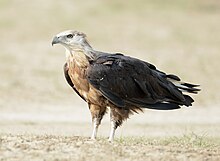Pallas's fish eagle
| Pallas's fish eagle | |
|---|---|

| |
| Scientific classification | |
| Kingdom: | |
| Phylum: | |
| Class: | |
| Order: | |
| Family: | |
| Genus: | |
| Species: | H. leucoryphus
|
| Binomial name | |
| Haliaeetus leucoryphus (Pallas, 1771)
| |
| Synonyms | |
|
Aquila leucorypha Pallas, 1771 | |
Pallas's fish eagle (Haliaeetus leucoryphus[2]), also known as Pallas's sea eagle or band-tailed fish eagle, is a large, brownish sea-eagle. It breeds in Central Asia, between the Caspian Sea and the Yellow Sea, from Kazakhstan and Mongolia to the Himalayas, Bangladesh and northern India. It is partially migratory, with central Asian birds wintering among the southern Asian birds in northern India, and also further west to the Persian Gulf.[3]
Description

It has a light brown hood over a white face. The wings are dark brown and the back rufous, darker underneath. The tail is black with a wide, distinctive white stripe. Underwings have a white band. Juveniles are overall darker with no band on the tail. It measures 72–84 cm (28–33 in) in length with a wingspan of 180–215 cm (71–85 in).[3] Females, at 2.1-3.7 kg (4.6-8.2 lbs), are slightly larger than males, at 2-3.3 kg (4.4-7.3 lbs).[4]
Its diet consists primarily of large freshwater fish. They also regularly predate water birds, including adult greylag geese, by assaulting them on the surface of the water and then flying off with the kill. Since that goose species is slightly heavier than the eagle, this is one of the greatest weight-lifting feats ever recorded for a flying bird. Another case of lifting a great load in this species is when, in the Yamuna River in north-central India, an eagle captured a huge carp and flew with the struggling fish very low over the water, before dropping it in response to gunfire. The carp was found to have weighed 6 kg (13 lb) about twice the weight of the eagle carrying it.[5]
Systematics
This species is the hardest-to-place sea-eagle. Among the species of its genus, it has no close living relatives. mtDNA cytochrome b sequence data is unable to reliably suggest a phylogenetic place for it among the sea-eagles. However, some information can be drawn from the molecular data, and especially from morphology and biogeography:
This species retains the ancestral dark eye, bill, and talons of the first sea-eagles, shared with the older tropical lineage. It is peculiar insofar as it has a black band at the end of the tail in adult birds, similar to juvenile Madagascar fish eagles (which look like a smaller, darker version of this bird, but are not very closely related). Its distribution indicates that this species evolved fairly independently of other sea-eagle lineages, but the molecular data tentatively suggests it is possibly closer to the Holarctic species.[6]
It diverged from its common ancestor with other species soon after the Holarctic and the tropical lineages split. Dependent on the interpretation of a possible Early Oligocene sea-eagle fossil from Egypt, this happened either at the very start or the end of the Oligocene, somewhere between 34 and 25 mya.[7] Apparently, this species achieved its current, essentially land-locked distribution peculiar among sea-eagles due to the collision of Indian Plate with Eurasia.
Thus, although the exact timing is not well resolved, it is quite certain that Pallas's fish eagles are the descendants of those sea-eagles which inhabited the northwestern Bay of Bengal when it was a shallow straits separating mainland Asia from India, which still was an island at that time.
Conservation status

The conservation status of Pallas's fish eagle is Vulnerable, with a population of about 2,500 to 10,000 remaining. Besides direct persecution, humans contribute to the decline of this species through habitat degradation, pollution, and draining or overfishing lakes. In India, the eagle is also threatened by the spread of water hyacinth (Eichhornia spp.) which spread over lakes and make finding prey difficult. The large range is deceptive, as Pallas's fish eagle is rare and isolated throughout its territory and may not breed in large areas of it.[3]
Footnotes
- ^ IUCN Red List 2014.
- ^ Etymology: Haliaeetus, New Latin for "sea-eagle". leucoryphus, "white-headed", from Ancient Greek leukos "white" + corypha, "head".
- ^ a b c del Hoyo, Elliott & Sargatal 1994.
- ^ Raptors of the World by Ferguson-Lees, Christie, Franklin, Mead & Burton. Houghton Mifflin (2001), ISBN 0-618-12762-3
- ^ Wood, Gerald (1983). The Guinness Book of Animal Facts and Feats. ISBN 978-0-85112-235-9.
- ^ Wink, Heidrich & Fentzloff 1996.
- ^ The caution advised by Wink et al. (1996) regarding their more recent estimates which were based on a small-bird rule-of-thumb mutation rate turned out to have been well justified. Molecular evolution in sea-eagles, as demonstrated by the fossil record, is very slow — up to an order of magnitude less than in perching birds.
- References
- Cited texts
- del Hoyo, J.; Elliott, A.; Sargatal, J., eds. (1994). Handbook of the Birds of the World. Vol. 2. Barcelona: Lynx Edicions. ISBN 84-87334-15-6.
{{cite book}}: Invalid|ref=harv(help) - Wink, M.; Heidrich, P.; Fentzloff, C. (1996). "A mtDNA phylogeny of sea eagles (genus Haliaeetus) based on nucleotide sequences of the cytochrome b gene" (PDF). Biochemical Systematics and Ecology. 24 (7–8): 783–791. doi:10.1016/S0305-1978(96)00049-X.
{{cite journal}}: Invalid|ref=harv(help)
External links
- ARKive: Images and movies
- BirdLife Species Factsheet
- H. leucoryphus range map (very large and slow to load)

